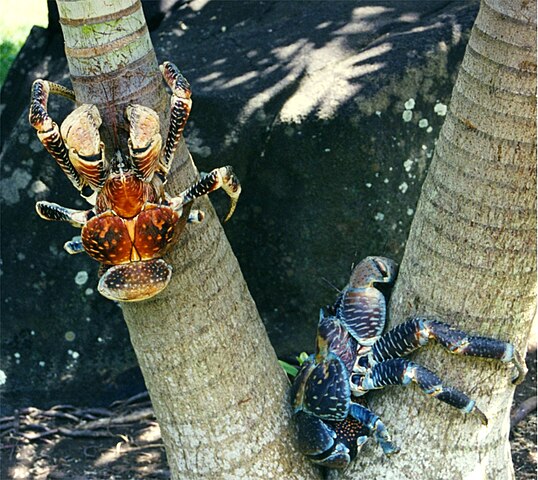
Why are coconut crabs so big? Coconut crabs are big because they need enough power to be able to crack coconuts.
Coconut crabs live on islands in the Indian and Pacific Ocean. They are enormous. They weigh about 4 kg and they have a leg span that can be over 1 m. They are not the largest crab in the world. That is the Japanese Spider Crab, which can weigh 20 kg and has a leg span of almost 4 m. However, most of the size of the Japanese Spider Crab comes in its long spindly legs, and its body is not actually that large, about 30 cm across. Coconut crabs have a much larger body in relation to their size and they have shorter, but thicker legs. They are the largest crab to live on land.
Coconut crabs are large because their main source of food is coconuts, hence their name, although that is not the only thing that they eat. They have two ways of opening coconuts and they often use a combination of methods. The part of the coconut that has the flesh and the milk is the seed inside the fruit that grows on the palm tree. They fall off when ripe and are able to float, which is how they can spread from island to island. The outer part of the fruit covers the husk and to get to the seed, that needs to be removed. The coconut crab can use its powerful claws to remove the outer fruit and most of the husk. Then, there are two things they can do. The first thing is to use their very strong claws to break the coconut up or to break holes into its shell. The second thing is to carry the coconut up a tree and drop it so that it breaks on the hard ground. Often, one method alone is not enough and the crabs will employ both methods until the shell is broken. When the coconut crab strips the husk off the coconut, they always start on the same side of the coconut. All coconuts have three germination pores on one side, which are the place where the new palm tree will grow out of the seed. This is a weak point in the shell and the coconut crabs will target that point to break into the shell with their claws. Once the shell is broken, they peel out the flesh and eat that.
If you have ever tried to crack a coconut, you know how much strength it takes. Most people will use tools to break one open. And that is the reason why coconut crabs are so big. They have gigantic pincers and very large forelegs, which gives them an enormous amount of force. Coconut crab pincers have been measured at 1,765 newtons, which is about 600 newtons more than the force we can produce with our jaws and about 1,300 newtons more than the force the average man can produce with their hands. With coconut crabs, the bigger the crab the more force they can produce with their pincers.
Coconut crabs are famous because of their size, but also because they live on land and because they can climb trees. They are born in the water and they lay their eggs in water, but when they grow up they develop lungs so that they can breathe air. If you put a coconut crab underwater, it would drown. They are also able to climb trees because of the way their legs are angled. Each leg is angled inward, with a claw like end. The pointed claw ends of their legs grip the tree and the inward angle of the leg allows them to keep the grip without much effort.
Coconut crabs also eat a lot more than just coconuts. They are omnivore scavengers and will eat pretty much anything that they can find. They eat other seeds, dead animals, eggs, dead crabs, the molted exoskeletons of crabs, their own molted exoskeleton, and even live animals such as birds and rats. They will eat anything that they can get their claws into. Adult coconut crabs don’t have any predators because they are too big, their shells are too strong, and their grip strength is too impressive. They do get eaten by birds and reptiles when they are young, though. Their biggest predator at the moment is actually humans because a lot of people eat them. They are so large that they have an awful lot of meat. It is difficult to protect the species and it is currently listed as a vulnerable species. And this is what I learned today.
Sources
https://www.nhm.ac.uk/discover/coconut-crabs-bird-eating-giants-on-tropical-islands.html
https://en.wikipedia.org/wiki/Coconut_crab
https://www.montereybayaquarium.org/animals/animals-a-to-z/japanese-spider-crab
